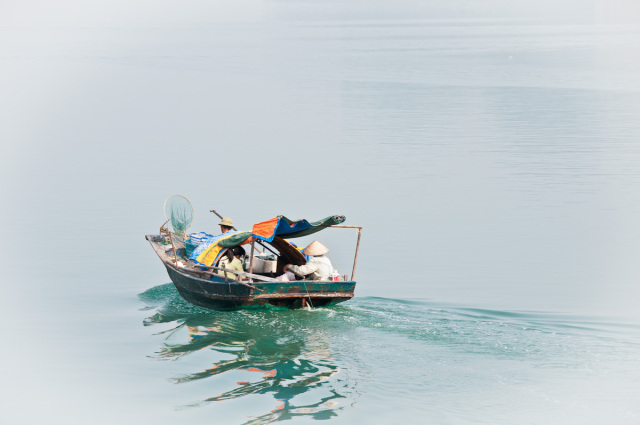“We live in a wonderful world that is full of beauty, charm and adventure. There is no end to the adventures we can have if only we seek them with our eyes open.” – Jawaharial Nehru
Mesmerizing panoramas of limestone karsts often covered with lush green vegetation. Adding to this backdrop was the ever present fishermen who live on these waters. We were never completely alone.
The put-put of their engines was the first indicator.
A single boat with Quonset hut and colorful flags passed by our junk oblivious to us watching.
Oftentimes boats were rafted together. This was home for them and a way of life dating back generations.
We notice a lone man in his boat tied to this grey ragged landscape collecting crustaceans. It is food for the table and to sell.
A cultural and colorful highlight was visiting a floating village tucked along the jagged edge of karsts in a somewhat protected area from the winds. Consisting of 120 people, mostly families with children, they have been there since 1994 and encouraged by the government to fish these waters. They do so with nets as well as fish-farms. There are three other such floating villages scattered throughout Halong Bay and some quite large. Collectively, these fishermen supply seafood to all of Vietnam, particularly Hanoi. In addition, they are developing markets for farm-raised sea grasses, sea weed, and shrimp.
Houses were painted in cheerful colors and each appeared to have a resident watch dog. Roosters crowed.
Generators provide electricity for the floating village and fresh water is brought in from the mainland and stored in tanks.
We were taken to the community building to meet the village elder, his family and to have tea. The structure also serves as a school while efforts are being made to replace the one that was destroyed in a typhoon. The government provides a teacher, but he or she needs to be married, which reflects the cultural morays. Older children who wish to further their education often live on the mainland with a relative.
Managing tourism is of importance. This village has a partnership with several junk touring companies. Only the smaller vessels can approach this particular floating village, which was a cultural bonus for us. Instead of selling us trinkets or local crafts, we were taken on small boat excursions. There were four couples in our group and each couple was assigned to a row boat made from a woven reed basket.
Our rower was a girl named Win who was shy and had such a lovely smile. By tipping these rowers we are told this is a “workable” situation for tourists and the village. I had to agree. These women worked hard at what they were doing. An extra cultural treat for Ron and I was Duc, our guide, joined our little boat as well as the village chief’s son and niece. It was fun listening to the children chatter away and Duc translate.
Laughing at each other in our conical hats was a reminder that we were acting the tourist part. There was one particular area that Duc wanted us to see, but the lead rower could not get her boat through because of the current.
We weren't disappointed. The beauty around us was worth this experience of being rowed in a basket.
Once back on the junk, the long term sustainability of these floating villages was discussed. There is a balance between the fishermen, tourism, and the fragile eco-system which can change because of industrial run off, storms affecting fishing and increasing pollution. Halong Bay is a beautiful natural wonder. Protection of these waters while preserving a cultural way of life is an ongoing challenge.
Source: onthegowithlynne
For more information about Halong Bay cruise, please refer: http://www.indochinasails.com/





Comments